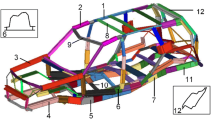Abstract
This paper presents a method to analyze thin-walled beams with quadrilateral cross sections reinforced with diaphragms using a one-dimensional higher-order beam theory. The effect of a diaphragm is reflected focusing on the increase of static stiffness. The deformations on the beam-interfacing boundary of a thin diaphragm are described by using deformation modes of the beam cross section while the deformations inside the diaphragm are approximated in the form of complete cubic polynomials. By using the principle of minimum potential energy, its stiffness that significantly affects distortional deformation of a thin-walled beam can be considered in the one-dimensional beam analysis. It is shown that the accuracy of the resulting one-dimensional analysis is comparable with that by a shell element based analysis. As a means to demonstrate the usefulness of the present approach for design, position optimization problems of diaphragms for stiffness reinforcement of an automotive side frame are solved.

















Similar content being viewed by others
References
Huang D, Wang TL, Shahawy M (1998) Vibration of horizontally curved box girder bridges due to vehicles. Comput Struct 68:513–528
Malen DE (2011) Fundamentals of automobile body structure design. SAE International, Warrendale
Li F, Patton R, Moghal K (2005) The relationship between weight reduction and force distribution for thin wall structures. Thin-Walled Struct 43:591–616
Patton R, Li F, Edwards M (2004) Causes of weight reduction effects of material substitution on constant stiffness components. Thin-Walled Struct 42:613–637
Sunami Y, Yugawa T, Yoshida Y (1990) Analysis of joint rigidity of the automotive body structure—out-of-plane bending of plane-joint structures. JSAE Rev 11(3):59–66
Sunami Y, Yugawa T, Yoshida Y (1988) Analysis of joint rigidity in-plane bending of plane-joint structures. JSAE Rev 9(2):44–51
Senjanović I, Tomašević S, Rudan S, Senjanović T (2008) Role of transverse bulkheads in hull stiffness of large container ships. Eng Struct 30:2492–2509
Senjanović I, Tomašević S, Vladimir N (2009) An advanced theory of thin-walled girders with application to ship vibrations. Mar Struct 22:387–437
Choi S (2016) Unified higher-order beam analysis for multiply-connected thin-walled box beams. Ph.D. Thesis. Seoul National University
Choi S, Kim YY (2016) Analysis of two box beams-joint systems under in-plane bending and axial loads by one-dimensional higher-order beam theory. Int J Solids Struct 90:69–94
Bebiano R, Gonçalves R, Camotim D (2015) A cross-section analysis procedure to rationalize and automate the performance of GBT-based structural analyses. Thin-Walled Struct 92:29–47
De Miranda S, Madeo A, Miletta R, Ubertini F (2014) On the relationship of the shear deformable Generalized Beam Theory with classical and non-classical theories. Int J Solids Struct 51:3698–3709
Ferradi MK, Cespedes X (2014) A new beam element with transversal and warping eigenmodes. Comput Struct 131:12–33
Ferradi MK, Cespedes X, Arquier M (2013) A higher order beam finite element with warping eigenmodes. Eng Struct 46:748–762
Vieira RF, Virtuoso FBE, Pereira EBR (2015) Definition of warping modes within the context of a higher order thin-walled beam model. Comput Struct 147:68–78
Carrera E, Giunta G, Petrolo M (2011) Beam structures: classical and advanced theories. Wiley, New York
Carrera E, Zappino E, Petrolo M (2013) Analysis of thin-walled structures with longitudinal and transverse stiffeners. J Appl Mech 80:011006
Jang GW, Kim MJ, Kim YY (2012) Analysis of thin-walled straight beams with generally shaped closed sections using numerically determined sectional deformation functions. J Struct Eng 138:1427–1435
Choi IS, Jang GW, Choi S, Shin D, Kim YY (2017) Higher order analysis of thin-walled beams with axially varying quadrilateral cross sections. Comput Struct 179:127–139
Gonçalves R, Ritto-Corrêa M, Camotim D (2010) A new approach to the calculation of cross-section deformation modes in the framework of generalized beam theory. Comput Mech 46:759–781
Piccardo G, Ranzi G, Luongo A (2014) A direct approach for evaluation of the conventional modes within the GBT formulation. Thin-Walled Struct 74:133–145
Kim JH, Kim YY (1999) Analysis of thin-walled closed beams with general quadrilateral cross sections. J Appl Mech 66:904–912
Jang GW, Kim YY (2010) Fully coupled 10-degree-of-freedom beam theory for piecewise straight thin-walled beams with general quadrilateral cross sections. J Struct Eng 136:1596–1607
Abaqus (2014) Abaqus/CAE user’s manual. Version 6.14
Bendsøe MP, Sigmund O (2003) Topology optimization: theory, methods and applications. Springer, Berlin
Svanberg K (1987) The method of moving asymptotes—a new method for structural optimization. Int J Numer Methods Eng 24:359–373
Acknowledgements
This research was supported by the Basic Science Research Program through the National Research Foundation of Korea (NRF) funded by the Ministry of Science, ICT, and Future Planning (NRF-2014R1A2A1A10051263).
Author information
Authors and Affiliations
Corresponding author
Appendices
Appendix
Shape functions for rigid body cross-section deformations of a general quadrilateral cross section
where \(\alpha _j \) angle between edge j and the x-axis, (\(x_j ,y_j )\) coordinates of corner j, (\(x_c ,y_c )\) coordinates of the geometric center, \(r_j\) distance from the shear center to edge j, \(l_j\) distance from corner j to the point \(N_j\) (\(N_j\): intersection between edge j and the normal line from the shear center to edge j).
In Eq. (A1), \(U_q \) and \(\theta _q ({q=x,y,z} )\) denote rigid-body translations and rotations of the cross section in the q-direction, respectively. Note that shape functions for bending deflection and bending/shear rotations are defined in terms of (x, y)-coordinates in Fig. 2, not necessarily in terms of principal coordinates.
Shape functions for torsional and Poisson distortions and corresponding warpings of a rectangular cross section
where b and h denote the width and height of a cross section (see Fig. 1).
Element stiffness matrix of a thin-walled beam with a rectangular cross section
The stiffness matrix of element e is given as

where l is the length of the element and \(s_i\) are cross-section coefficients defined as
The associated degrees of freedom for the stiffness matrix in Eq. (A3) are
Rights and permissions
About this article
Cite this article
Jung, J.H., Jang, GW., Shin, D. et al. One-dimensional analysis of thin-walled beams with diaphragms and its application to optimization for stiffness reinforcement. Comput Mech 61, 331–349 (2018). https://doi.org/10.1007/s00466-017-1452-x
Received:
Accepted:
Published:
Issue Date:
DOI: https://doi.org/10.1007/s00466-017-1452-x




